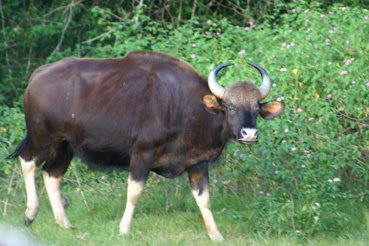short URL for this story : http://goo.gl/WxBjU
Indian Bison (Bos Gaurus),
one of the eight species of wild bovid in Asia, is finding its grip on
existence loosening in the Shiwalik hill ranges in India due to a wide range of
issues, reports a scientific correspondence published in the latest issue of
Current Science journal.
 |
| Indian Bison (Bos Gaurus) Image Courtesy: Wikimedia Commons |
The large ungulate which is also known as ‘Gaur’, is threatened
by food scarcity, competition from domestic cattle and poaching across the
border in the Valmiki Tiger Reserve (VTR) which is the last home to these
animals in the Shiwalik hills, says the correspondence. Though, the local
people report that the reserve had a large gaur population in the past, now it
has been reduced to a mere 50 individuals, it says.
As per the research correspondence, Gaur population in the
North East Indian region is mainly located in interconnected forest areas
between Nepal and India. While some 296 gaurs are estimated to live in Chitwan NationalPark and Parsa Wild Life Reserve in Nepal, an estimated 50 member strong gaur
population resides in Valmiki Tiger Reserve (VTR) in the Indian region.
Major threats to Gaur
population in VTR
Destruction of grasslands due to planting of non-native
commercially important trees species like Tectona
Grandis and the presence of strong invasive species like dwarf Phoenix in understory
vegetation and Mikania sp. In the stream side flora has reduced the food
availability of the remaining population of bison in the Shiwallik, shows the
correspondence.
Though VTR harbors different variety of grass species
including Lagerstroemia parviflora, Saccharum spontaneum, Mallotus
phillippinensis, Adina cordifolia, Shorea robust, Imperata
cylindrical and Sclerostachya fusca, which are favorites in the Gaur
menu, indiscriminate grazing by domestic cattle from the villages nearby the
reserve is also raising multiple threats to the Gaurs here, says the study.
While the domestic cattle compete with for food resources,
they also make the chances of contracting foot and mouth diseases, pests and
anthrax to their wild cousins. Though no such reports are made so far, the
chances still lingers.
Though official records are not available, poaching still
seems to be a major reason which has brought down the gaur population in the
area considerably. Gaur meat has high demand in the illegal markets on both
sides of the Indo-Nepal border which makes it a favorite target for poachers.
The Grim picture
The conservation status of Guars has been grim in India
recently, says the correspondence. The animal has been reportedly exterminated
from at least three protected areas in different parts of the country in recent
years. Presently, VTR is the only protected area in the Shiwalik hills to
shelter it, which makes the bison population here crucial in conservation
perspective. Since it is a major animal in the prey base of the carnivores in the
area, including the endangered tiger, any threat to the existence of the gaur
population will indirectly affect the tiger population in VTR and adjacent Chitwan
National Park also.
Gaur is already categorized as Vulnerable by IUCN Red Data
list and has been included in the Schedule I of the Wild life (Protection) Act,
1972 of India due to its diminishing population trend in the country.
To improve the gaur population in the area, the correspondence
suggests manual clearing of invasive plants species from the reserve and growing
native plants which are favored food species of Gaurs. It also calls for a
regulation in indiscriminate cattle grazing in the reserve.

No comments:
Post a Comment
Please feel free to have your say on our stories. Comments will be moderated. anonymous Comments will not be approved. No links in the comment body unless meant for sharing a very relevant info.